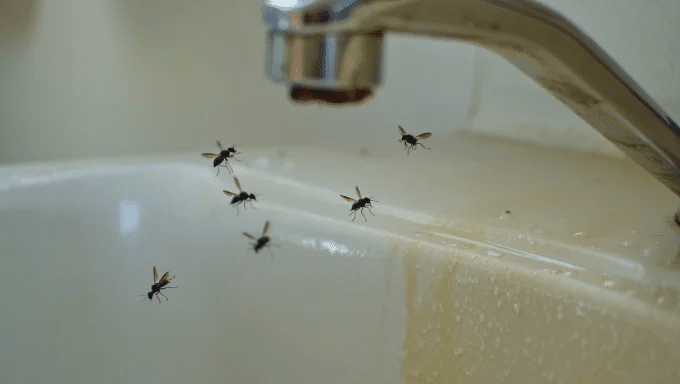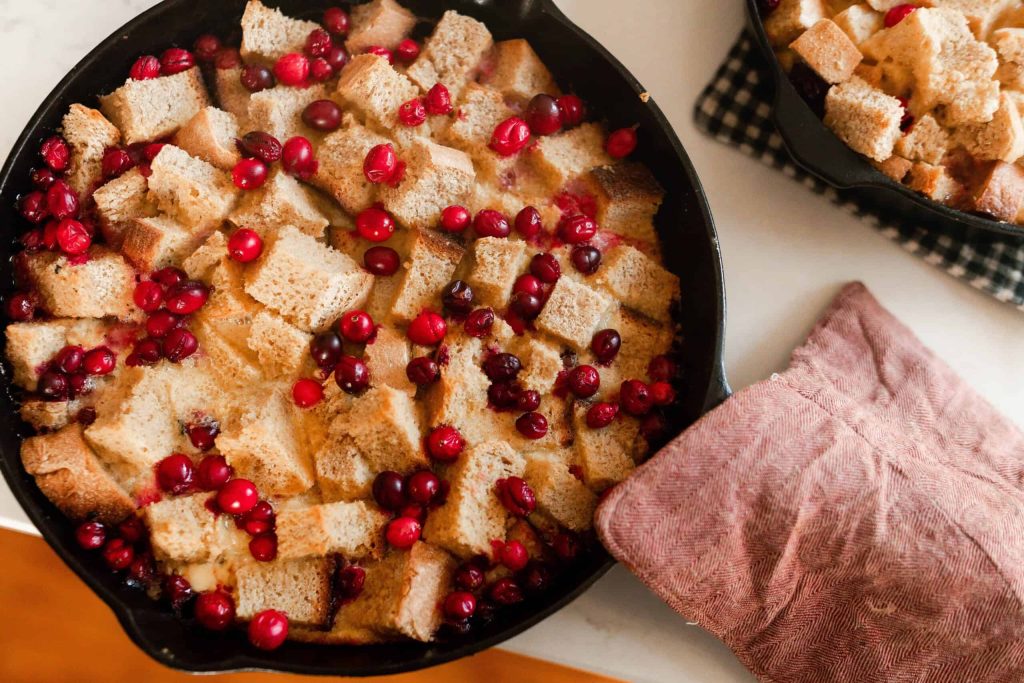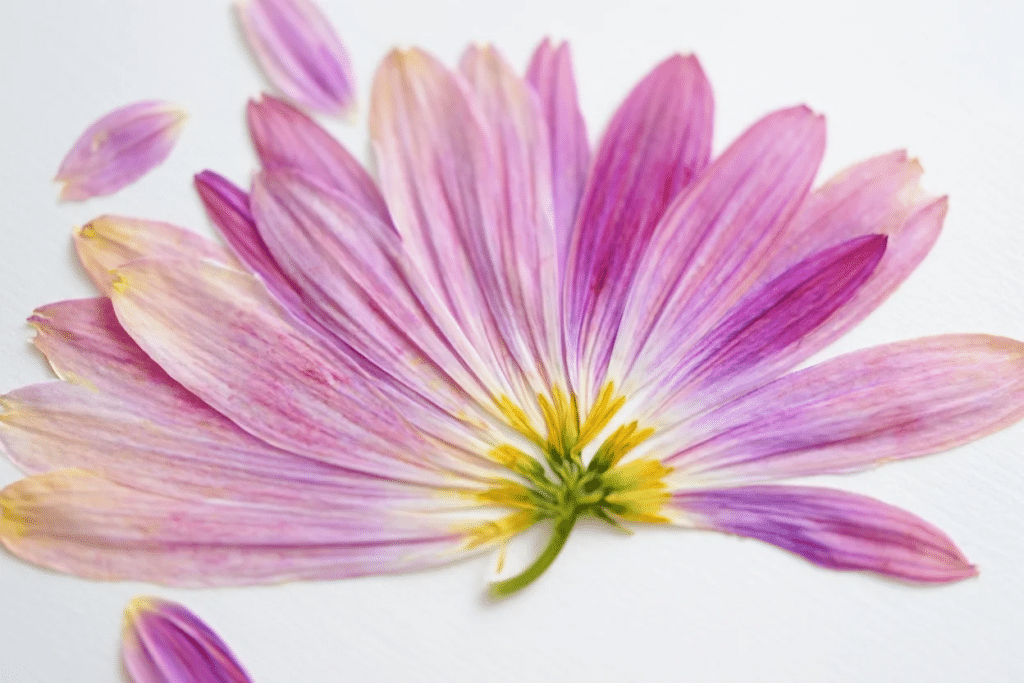Fed up with tiny gnats buzzing around your kitchen? You’re not alone. These annoying little bugs seem to come from nowhere, and they grow in numbers fast. One day your kitchen looks clean, the next day it’s full of flying pests.
You don’t need expensive sprays or strong chemicals to beat them. Most gnats’ fixes are already in your kitchen right now. And they really work.
Whether they’re flying around your fruit or coming from your sink, gnats are more than just annoying. They’re gross and embarrassing when people come over.
Want your kitchen back? These five simple remedies will help you get rid of gnats for good, using everyday stuff you probably already have
What is a Gnat? And Its Various Types
A gnat is a tiny flying insect that measures only 1to 4 millimeters long, about the size of a pinhead.
These small pests are often mistaken for baby flies, but they’re actually fully grown adults from various insect families.
Common types of gnats found in kitchens:
- Fruit flies: The most common kitchen gnat, attracted to ripe or rotting fruits and vegetables. They have red eyes and tan-colored bodies.
- Fungus gnats: Dark-colored gnats that breed in moist soil of houseplants and love damp areas around sinks.
- Drain flies: Fuzzy-looking gnats that live and breed in kitchen drains where food particles collect
Where are the Gnats Coming From?
Understanding where kitchen gnats originate helps you target the problem at its source and prevent future infestations more effectively.
1. Your kitchen sink and drains: Your sink and drains are gnat-breeding hotspots. Food bits, grease, and gunk in pipes create perfect moist spots for eggs. Even tiny scraps support whole gnat families.
2. Overripe fruits and vegetables: Overripe fruits on counters work like gnat magnets. As they ripen and ferment, sweet smells attract flies from everywhere. One forgotten banana can start a major bug invasion.
3. Houseplants with wet soil: Houseplants with wet soil often harbor fungus gnats, especially if you tend to overwater them. These tiny flies live in the moist potting soil and can easily spread from your plants to other areas of your kitchen.
4. Trash cans and compost bins: Trash cans and compost bins make perfect breeding spots, especially with food scraps inside. When not emptied regularly, the rotting stuff creates ideal conditions for more gnats.
5. Outside entry points: Outside entry points include small cracks around windows, doors, and vents where gnats can fly in from outdoors. They’re also attracted through open doors and windows, especially during warm weather when they’re most active.
6. Hidden spills and crumbs: Hidden spills and crumbs under appliances, in pantries, or behind cabinets can sustain gnat populations for weeks without you realizing the source of the problem.
Remedy for fixing Gnat Infestations
If you’re wondering how to get rid of gnats in the kitchen effectively, these five proven remedies will help you reclaim your space.
1. Apple Cider Vinegar and Soap
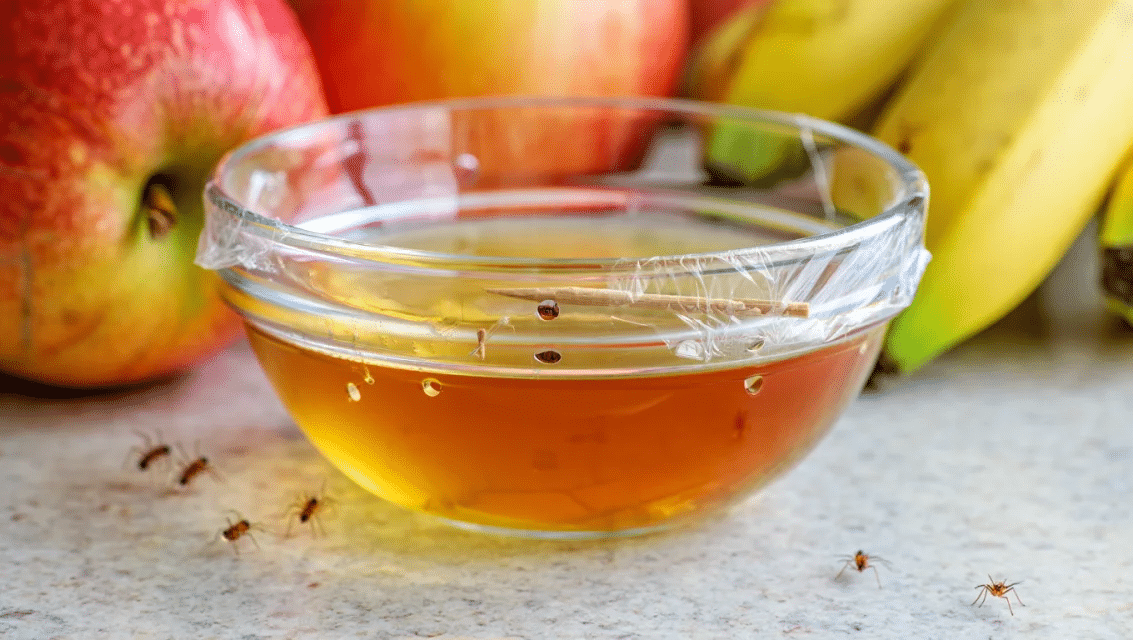
Kitchen gnats can change your cooking space from a culinary haven into a frustrating battleground.
These tiny pests seem to appear out of nowhere, buzzing around your fresh fruit, hovering near the sink, and making meal preparation an unpleasant experience.
What you’ll need:
- Apple cider vinegar
- Small bowl or jar
- Plastic wrap
- Toothpick
How it works: Fill a small bowl with apple cider vinegar and cover tightly with plastic wrap. Poke several small holes in the plastic with a toothpick. The sweet scent attracts gnats, but once they enter through the holes, they can’t escape.
2. Flush and Clean the Sink Drains
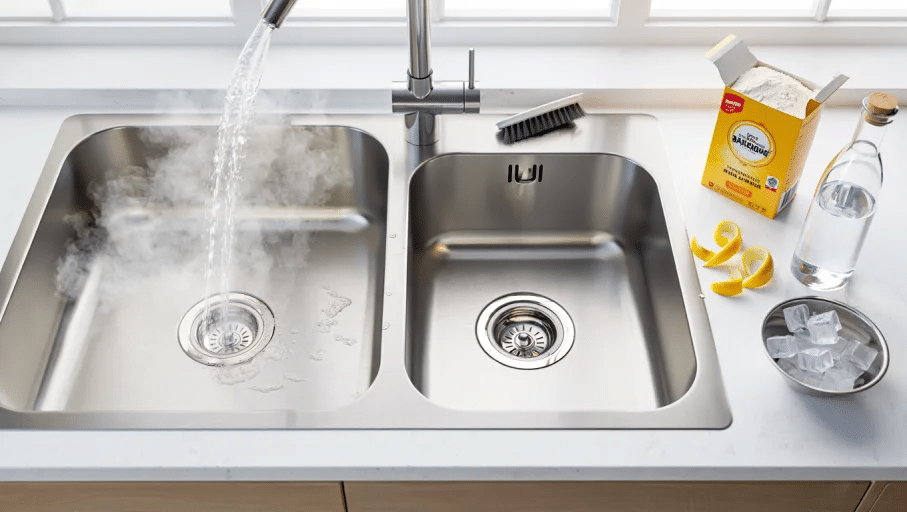
Kitchen sinks often harbor a perfect breeding ground for gnats. Food particles, grease buildup, and standing water create ideal conditions for these pests to multiply.
The solution:
- Pour boiling water down all drains.
- Scrub the sink thoroughly with baking soda and vinegar.
- Use a drain brush to remove buildup in pipes.
- Run the garbage disposal with ice cubes and lemon peels.
3. Remove Their Breeding Grounds
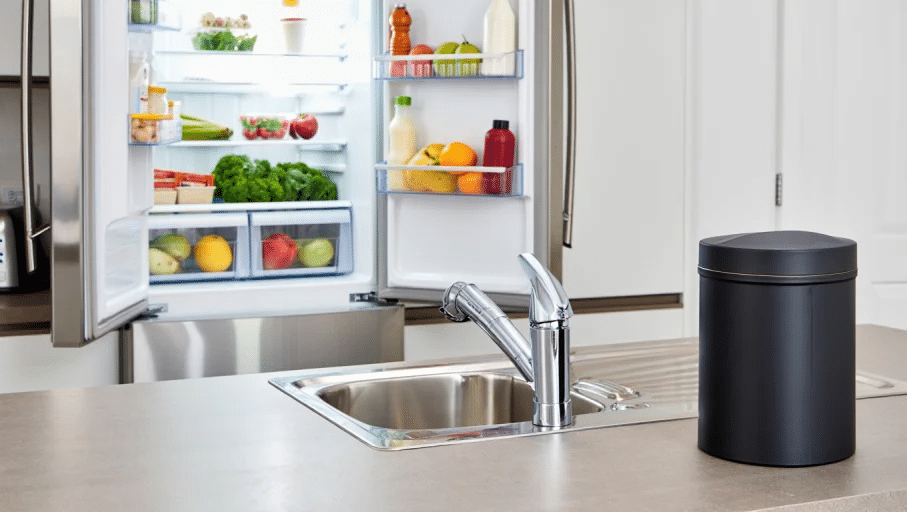
Immediate actions:
- Store all ripe fruit in the refrigerator
- Clean up spills and crumbs immediately
- Take out the garbage daily
- Wipe down counters with disinfectant
- Check for hidden food sources like crumbs under appliances
Long-term prevention: Gnats are attracted to sugary, fermenting substances. By eliminating these food sources, you’re addressing how to get rid of gnats in the kitchen at the source level, making your space less appealing to these unwanted visitors.
4. Essential Oil Spray Deterrent
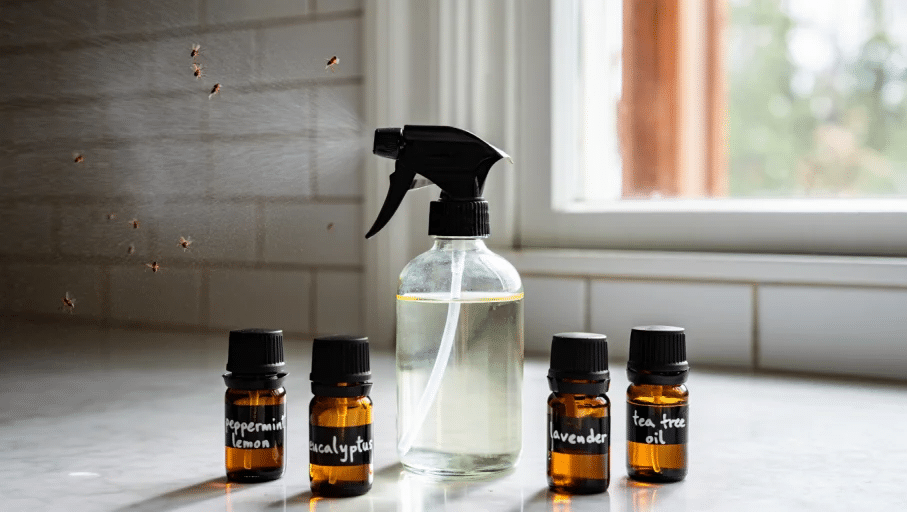
Natural essential oils provide a chemical-free way to repel gnats while leaving your kitchen smelling fresh. Certain scents that humans find pleasant are overwhelming and offensive to these tiny insects.
Mix 10 drops of peppermint essential oil and 10 drops of lemon essential oil with 2 cups of water in a spray bottle. Shake well before each use and spray around windowsills, countertops, and anywhere you’ve seen gnats gathering.
Additional oils that work: Eucalyptus, lavender, and tea tree oils are also effective gnat deterrents. You can experiment with different combinations to find scents you enjoy while keeping pests away.
Tips to Amplify Success in Getting Rid of The Gnats
Getting rid of gnats requires a multi-pronged approach that targets both the adult insects you see and their hidden breeding sources.
These tips will help you eliminate current infestations and prevent future problems when applied consistently.
Identify and Eliminate the Source – Check potted plants, drains, garbage areas, and fruit bowls. Remove overripe fruit immediately. Clean drains completely. Let the plant soil dry between waterings.
Target Adult Gnats – Mix apple cider vinegar with one drop of dish soap in small bowls – place near problem areas. Gnats drown when attracted to scent.
Address Fungus Gnats in Plants – Let the soil dry completely between waterings. Add a sand layer on top of the soil. Use yellow sticky traps near plants to catch flying adults.
Clean Thoroughly – Wipe all surfaces around sinks and food areas, clean garbage disposal with ice and citrus. Scrub drains with baking soda and vinegar.
Improve Drainage and Ventilation – Fix leaky pipes and improve air flow. Remove standing water everywhere. Reduce humidity since gnats need moisture to survive and reproduce successfully.
Natural Deterrents – Mix peppermint, eucalyptus, or lemongrass essential oils with water. Spray around problem areas. These scents naturally repel gnats from treated spaces.
Be Patient but Persistent – Takes 1-2 weeks to break the breeding cycle. Continue traps and moisture control even after seeing fewer adults to eliminate remaining eggs.
How to Get Rid of Gnats in Sink Areas
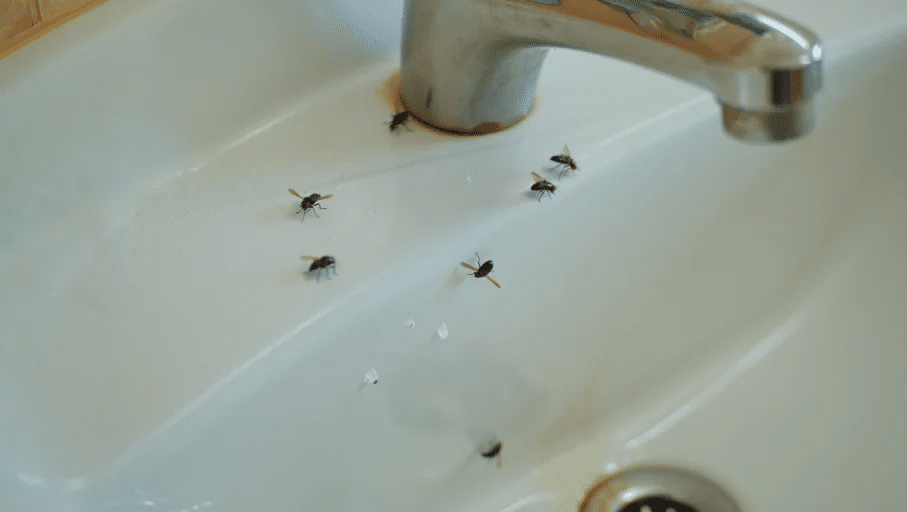
Your drain is likely their breeding ground. Pour boiling water down all drains to kill eggs and larvae hiding in the pipes.
Next, sprinkle baking soda followed by white vinegar down the drain – this fizzing action helps remove buildup where gnats lay eggs.
Use an old toothbrush or drain brush to scrub around the drain opening and remove any food particles. Run your garbage disposal with ice cubes and citrus peels to clean the blades thoroughly.
Finally, keep your sink completely dry between uses, as gnats need moisture to survive. Clean your drains weekly using this method to prevent future infestations and maintain a gnat-free kitchen sink area.
Real-Life Success Stories from Forums
1. A Quora user shared that placing a bowl of apple cider vinegar with plastic wrap near their fruit basket cleared out all the gnats in just two days. (Read more here)
2. On Reddit, one user described using a travel-sized spray bottle filled with water and Dawn soap to target gnats directly, starting with 15 a day and reaching zero in just a week. (See full comment here)
3. Another Reddit user reported success by combining multiple tactics- mint essential oil down the drain, Windex with ammonia, and sealing sink drains overnight to eliminate the infestation completely. (View the thread here)
To Conclude
Getting rid of kitchen gnats doesn’t have to be complicated or expensive. These five simple remedies work because they tackle the problem at its source.
Clean your drains regularly, store fruits properly, and keep surfaces dry. It’s that straightforward. Gnats multiply fast, but they also disappear quickly when you remove what they need to survive.
Start with the remedy that matches your biggest problem area – whether that’s your sink, fruit bowl, or houseplants.
Your kitchen should be a place you enjoy, not a battleground with flying pests.


